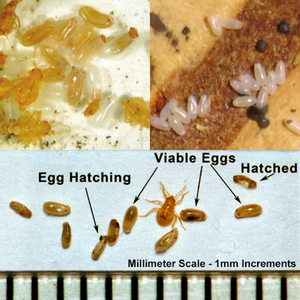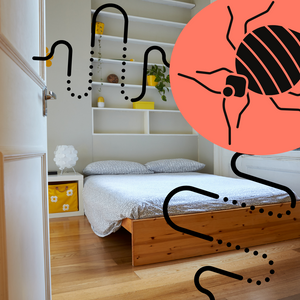Bed Bug Residual Spray

When it comes to choosing the treatment to get rid of bed bugs, many are torn between the different options available. Among the popular and go-to solutions of many is the use of bed bug sprays. However, many are confused about the sprays that they should get.
There are two types of sprays that you can use to kill bed bugs. One is contact spray that requires you to spray it directly to bugs to kill them. However, the effectiveness it is offering is limited. Most contact killers have pyrethrum as its natural pesticide.
Another type is residual sprays. These sprays are often made of synthetic man-made pesticides that can stay effective for a maximum period of 16 weeks. Safety-wise, pesticides with deltamethrin are deemed safer and widely used by pest control professionals to deal with bed bugs.
How Does Residual Bed Bug Spray Work?
Residual insecticides last longer than contact insecticides. This means that you do not have to directly spray it on bed bugs. It is highly recommended that it sprayed on every crack and crevice of bed frames, beds, drawer tracks, furniture, and general areas where you do not make any skin contact.
The insecticide acts as a barrier against bed bugs and leaves lasting effects. Among the active ingredients found in residual sprays like Blaze Pro Residual Bed Bug Killer is Permethrin. This chemical is known for attacking the nervous system of the bug. It is also widely used in the pest industry because of its potency.
Permethrin is a synthetic chemical that is extracted from chrysanthemum flowers. These insecticides are also mixed with preservatives. For Blaze Pro, it contains 1,2-benzisothiazolin-3-one that is at 0.0193% concentration to make the efficacy of Permethrin last longer.
For most brands, about three treatments using this spray in combination with bed bug powder at least every two weeks is recommended. Make sure that you read the label to know how you should apply it and the areas where you can apply it. An important reminder that you should keep in mind is that using killers spray and insecticidal dusts will not treat the bed bug infestation right away.
You can spray a residual bed bug killer on surfaces like mattresses, bedding, and furniture. However, you should always use it according to the instructions stated on its label. You need to check the package all the time to ensure the safety of everyone when using insecticides indoors.
When all surfaces are cleaned thoroughly, it might not be necessary to use a residual bed bug killer. However, you can never tell if you missed certain areas where the bed bugs and eggs are hiding.

They can be tucked safely in the side of your mattress. This is where the residual effect of these insecticides come in handy. It will eliminate the remaining survivors of the previous cleaning process you did to get rid of the pests. Furthermore, it will help prevent a re-infestation from happening.
All you need to do is spray lightly on the seams and folds of the mattress. Make sure that you also apply it to the undersides of the bedside furniture as well as the bed frame.
You do not want to spray too much as it may only spread the more than containing the infestation. It can work effectively, but make sure that you do not spray too much.
Keep in mind that not everyone has the access to the same type of spray so the results of such treatments may always vary to the type of spray you use. Also, not all sprays used for treating bed bugs are available in the market. Pest control specialists are using much stronger variants that you might not found in the market or not sold for DIY applications.
Bed bugs do not easily die by simply walking across the treated area. Most of the time, they need to stay in the area for a couple of days before they absorb it and die. This is the main reason why you should apply residual sprays in areas where they spend most of their time hiding.
Residual Bed Bug Spray Canada
When it comes to insecticides, Canada has restrictions with the type of insecticides allowed to use in both residential and commercial establishments. On the other, restrictions vary from state to state in the USA. It is recommended that you check what types of sprays or specific brands are authorized to be used in your state.
Things to Remember When Using Insecticide for Treating a Bed Bug Infestation
There are certain things that you should keep in mind as you choose a specific insecticide and use them in your home. Follow the steps below in safely using insecticide in your home:
- The label should indicate the is meant for indoor use. There are only a few insecticides that are safe to be used around kids and pets. When the insecticide’s label also includes outdoor use, it may cause serious health risks to both humans and animals exposed to it.
- See to it that the label indicates that it is meant for killing or is effective in getting rid of bed bugs. Keep in mind that not all insecticides work in killing these critters.
- Read the label carefully and follow the directions of use.
- Never attempt to apply more than what is required. As mentioned, too much use of insecticide may only worsen the problem. Also, if it does not work for the first time, adding more will not solve it either.
- Do not use insecticide on your bedding or mattress unless it is stated on the label of the spray bottle.
Aside from the fact, there are only a few that will work effectively in killing bed bugs, you should also keep in mind that there are now pyrethroid-resistant bed bugs. This means that pyrethroid products alone will not work in killing these critters. It should be used along with other products for it to work.
Also, keep in mind that not all products indicating that it can eradicate bed bugs will help in controlling the infestation. Depending on the level of infestation, the combination of various treatments may be required to put an end on the infestation in your home.







